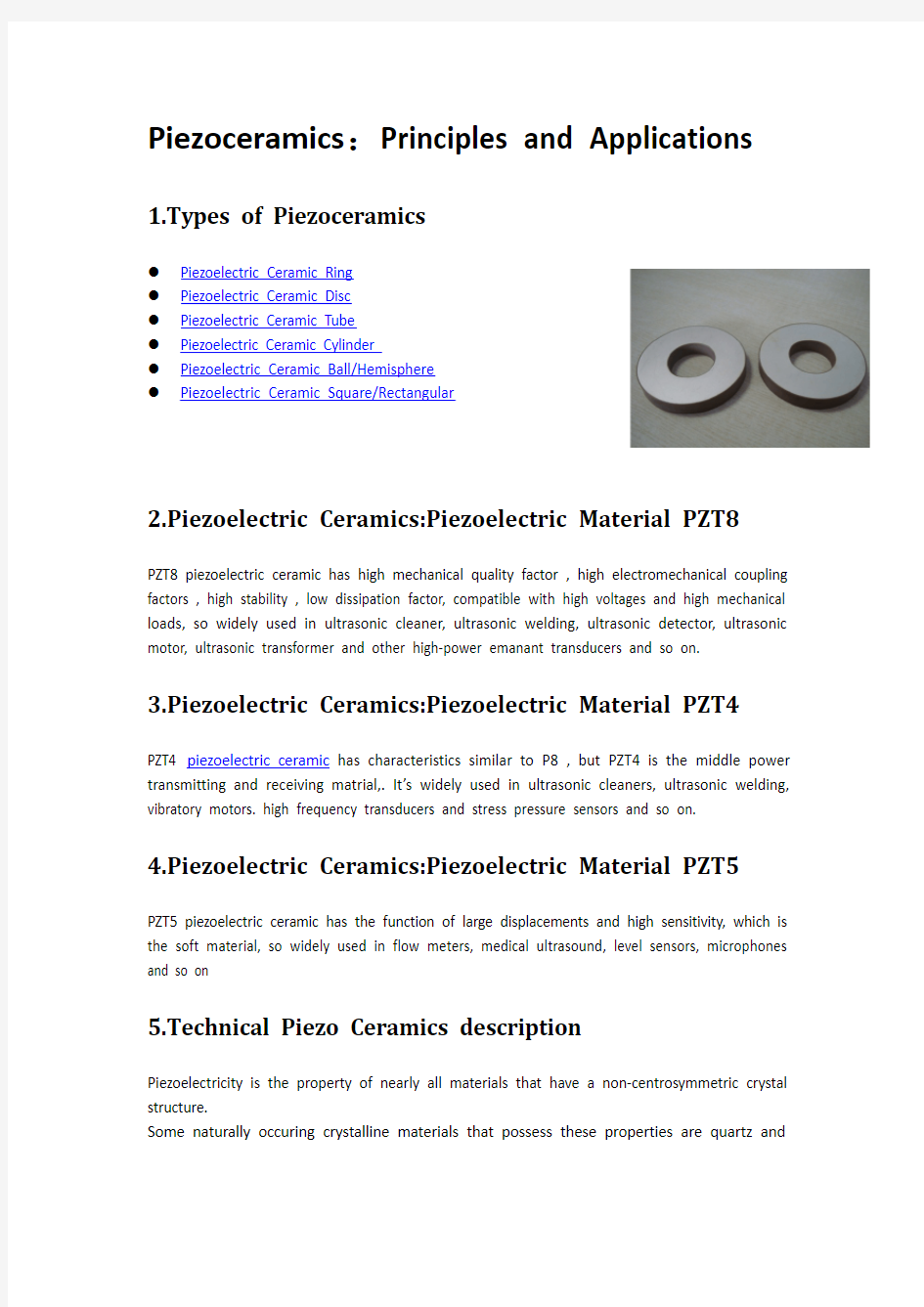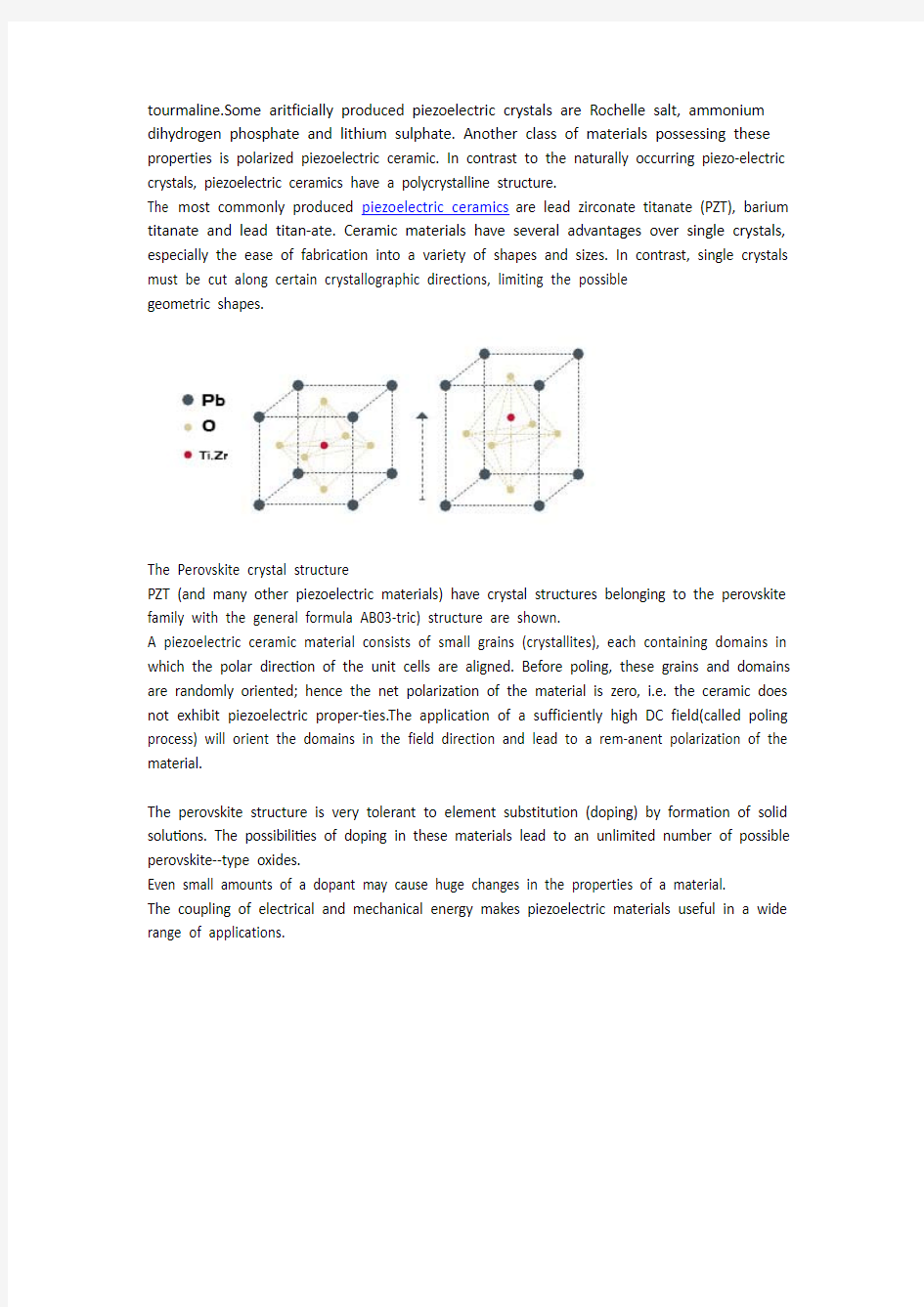压电陶瓷的原理与应用


Piezoceramics:Principles and Applications
1.Types of Piezoceramics
●Piezoelectric Ceramic Ring
●Piezoelectric Ceramic Disc
●Piezoelectric Ceramic Tube
●Piezoelectric Ceramic Cylinder
●Piezoelectric Ceramic Ball/Hemisphere
●Piezoelectric Ceramic Square/Rectangular
2.Piezoelectric Ceramics:Piezoelectric Material PZT8
PZT8 piezoelectric ceramic has high mechanical quality factor , high electromechanical coupling factors , high stability , low dissipation factor, compatible with high voltages and high mechanical loads, so widely used in ultrasonic cleaner, ultrasonic welding, ultrasonic detector, ultrasonic motor, ultrasonic transformer and other high-power emanant transducers and so on.
3.Piezoelectric Ceramics:Piezoelectric Material PZT4
PZT4 piezoelectric ceramic has characteristics similar to P8 , but PZT4 is the middle power transmitting and receiving matrial,. It’s widely used in ultrasonic cleaners, ultrasonic welding, vibratory motors. high frequency transducers and stress pressure sensors and so on.
4.Piezoelectric Ceramics:Piezoelectric Material PZT5
PZT5 piezoelectric ceramic has the function of large displacements and high sensitivity, which is the soft material, so widely used in flow meters, medical ultrasound, level sensors, microphones and so on
5.Technical Piezo Ceramics description
Piezoelectricity is the property of nearly all materials that have a non-centrosymmetric crystal structure.
Some naturally occuring crystalline materials that possess these properties are quartz and
tourmaline.Some aritficially produced piezoelectric crystals are Rochelle salt, ammonium dihydrogen phosphate and lithium sulphate. Another class of materials possessing these properties is polarized piezoelectric ceramic. In contrast to the naturally occurring piezo-electric crystals, piezoelectric ceramics have a polycrystalline structure.
The most commonly produced piezoelectric ceramics are lead zirconate titanate (PZT), barium titanate and lead titan-ate. Ceramic materials have several advantages over single crystals, especially the ease of fabrication into a variety of shapes and sizes. In contrast, single crystals must be cut along certain crystallographic directions, limiting the possible
geometric shapes.
The Perovskite crystal structure
PZT (and many other piezoelectric materials) have crystal structures belonging to the perovskite family with the general formula AB03-tric) structure are shown.
A piezoelectric ceramic material consists of small grains (crystallites), each containing domains in which the polar direction of the unit cells are aligned. Before poling, these grains and domains are randomly oriented; hence the net polarization of the material is zero, i.e. the ceramic does not exhibit piezoelectric proper-ties.The application of a sufficiently high DC field(called poling process) will orient the domains in the field direction and lead to a rem-anent polarization of the material.
The perovskite structure is very tolerant to element substitution (doping) by formation of solid solutions. The possibilities of doping in these materials lead to an unlimited number of possible perovskite--type oxides.
Even small amounts of a dopant may cause huge changes in the properties of a material.
The coupling of electrical and mechanical energy makes piezoelectric materials useful in a wide range of applications.
Electric dipoles in piezoelectric materials before, during and after poling
Constitutive equations
The piezoelectric effect depends on directions. The reference axis, called axis 3, is taken parallel to the direction of poling. Axes 1 and 2 coordinate system with axis 3. 4, 5 and 6 represent shear movements around axes 1, 2 and 3 respectively.
Piezoelectric coefficients
Based on this coordinate system,the piezoelectric effect can be described in a simplified way by matrix coefficients. The coefficients “d” and “sE” are commonly used.
Basic piezoelectric equations
These coefficients are used to relate the strain “S”(6-components tensor) to the stress “T” and electrical field “E”(3-components vector).
S = sE.T + d.E
Designation of axes in piezoelectric materials
In this equation, the “sE.T” term describes the mechanical compliance of the component, simi-larly to any mechanical component. The “d.E” term describes the piezoelectric effect, i.e. strain generated by electrical field.
The above equations are useful for designing a piezoelectric application. However, it must be kept in mind that they represent an approximation.
相关文档
- 压电陶瓷材料及应用
- 压电陶瓷材料及其应用研究
- 压电陶瓷分类及应用
- 压电陶瓷及其应用
- 压电陶瓷的基本原理和应用
- 压电陶瓷发电特性及其应用研究共3篇
- 压电器件的种类特点及应用
- 压电陶瓷的工作原理及应用
- 压电陶瓷的工作原理及其应用
- 压电陶瓷的力学特性与应用研究
- 简述压电陶瓷在乐器识音方面的应用
- 压电陶瓷技术发展的历史与应用
- 压电陶瓷用途
- 压电陶瓷材料在储能装置中的应用
- 压电陶瓷材料的研究和应用
- 压电陶瓷的工作原理与应用
- 压电陶瓷前景
- 压电陶瓷发展前景及应用
- 压电陶瓷及其应用..
- 压电陶瓷的特性及应用举例
最新文档
- 线粒体糖尿病的临床特征与应对【下】
- 酵母菌线粒体的生物学研究以及其在健康与疾病中的作用
- 线粒体功能和失调对人体健康的影响
- 线粒体在疾病发生中的作用
- 线粒体糖尿病临床检验诊断专家共识
- 线粒体在细胞代谢中的作用
- 3种不常见的特殊类型糖尿病
- 邢小燕:不同类型糖尿病与遗传,看这篇文章就够了
- 氧化应激和线粒体
- 线粒体基因突变与妊娠糖尿病
- 糖尿病论文神经性耳聋论文:伴有糖尿病及神经性耳聋的线粒体脑肌病1例
- 线粒体功能与疾病
- 一种特殊类型:线粒体糖尿病
- 线粒体的功能与疾病
- 线粒体功能异常与代谢性疾病
- 线粒体的生物学意义及其功能调控
- 八年级物理教案 认识运动9篇
- 认识运动的辩证规律
- 人类认识运动的基本过程
- 简述认识的辩证运动的规律
